Abstract
The article presents the results of monitoring the level and quality of life of the population of rural areas, which was carried out as part of a grant study on materials from municipalities (municipal districts and rural settlements) of the Omsk region. According to the resulting total score, municipalities are grouped by the level of socio-economic development from high to crisis ones. At the same time, the territory of the municipality is considered to be at a high level of development, where social and engineering infrastructure is developing, the population is increasing and their incomes are growing, and local government bodies pay attention to environmental safety issues. Territories with a crisis level of development include municipalities in which there is a low level of quality of life, population outflow. These municipalities pay no attention to the development of social and engineering infrastructures. There is also a poor level of environmental safety. Monitoring the developed indicators in dynamics over a number of years (at least two years) will make it possible to judge the quality of social policy implementation for the development of rural areas in the context of municipalities. These municipalities can become a justification for making strategic decisions in the field of municipal management in the framework of the development of socio-economic policy aimed at improving the life of the rural population. The grouping of quality indicators by criterion blocks can orient the executive authorities to determine priority areas of development and identify “weak” points, localize problem situations.
Keywords: Monitoring, quality of life, rural areas, rural population, sustainable development, standard of living
Introduction
Modern realities show that indicators of the level and quality of life of the population reflect their socio-economic situation. The asynchrony of the socio-economic development of individual territories in the context of the country is reflected in the standard of living of people. First of all, those living in rural areas (Veliky, 2019; Yurkova et al., 2020).
The regional strategy of socio-economic development in the Omsk region provides for a system of measures aimed at improving the level and quality of life of the population in rural areas (Program of the Omsk region “Strategy for the socio-economic development of the Omsk region until 2025”). The complex internal organization and management mechanism of the socio-economic system of the region determines the need to fulfill the requirements for these indicators in terms of reliability, efficiency of collection and processing of information for making timely effective management decisions, a systematic and integrated approach to assessing the dynamics of quantitative and qualitative indicators characterizing various aspects development, independence and objectivity (Veshnyakova & Chentsova, 2008). This approach determines the synchronization in the socio-economic development of territories in a future perspective and the formation of a balanced management policy at the regional and municipal levels. Evaluation of the effectiveness of such a mechanism requires the development and application of methodological tools for the analysis (monitoring) of the prevailing conditions in order to improve the quality of management decisions. Therefore, the development of such tools is an urgent scientific and practical task.
Problem Statement
Appropriate indicators of socio-economic development are established in the strategic development of regional programs, taking into account the smoothing of territorial differences and the specifics of rural areas in comparison with urban areas. These documents determine possible mechanisms for their achievement, as well as various sources of funds. The development of rural areas today is a priority in such programs because they are implementing the most important production, economic and socio-economic functions. They reflect the level and quality of life of the population of these territories (Nikitina, 2019; Shmakov, 2020). Therefore, approaches to assessing the quality of life of the population in general and the rural population have always been and remain relevant. Recently they have acquired a global strategic character. At the same time, methods for assessing the above-mentioned indicators were developed by both foreign and domestic researchers (Faronova et al., 2020; Shuvalova, 2018). The methodology of foreign concepts is based on the ideas of the existentialist approach and the concept of needs by Maslow and Allardt (Maslow, 1999). Domestic developments are focused on indicators for the region, without revealing the peculiarities of the social status of rural settlements (Ayvazyan, 2002, Bobkov, 2009). Based on the fact that there is no single integral indicator reflecting an objective characteristic of the quality of life of the rural population, it is necessary to calculate a number of indicators reflecting the quantitative and qualitative aspects of this category grouped into several blocks (Shumakova & Kutuzova, 2016).
Research Questions
When designing and implementing economic transformations in the region, the social aspect is considered in the context of the social consequences of economic changes. The dependence of the social development of rural areas on the level and quality of life of the rural population has not been sufficiently studied.
According to existing studies, the quality of life is presented as a kind of aggregated approach to assessing the degree of satisfaction of an individual with his needs. However, this approach is ambiguous: assessment is considered as a level of satisfaction with one's existence, while the efforts made to achieve it are being assessed. It is important to understand that the socio-economic situation of the regions differs from one to the other, which leaves an imprint on the choice of the above criteria. The lag in terms of the level and conditions of life support of rural areas from urban areas increases with the growth of unprofitable enterprises in rural areas, with a decrease in the development of social and engineering infrastructures, which have a negative impact on the availability and quality of social services for the rural population. Based on the foregoing, the quality of life of the rural population should be considered as a complex characteristic of the conditions of its life.
Studies of life quality indicators and scientific substantiation of their results are possible if they are quantitatively certain for the possibility of their measurement, analysis and grouping. At the same time, it is impossible to assess the quality of life without factors of economic growth and social achievements, which reflects the qualitative characteristics of this category.
Since there is no single integral indicator that gives an objective characteristic of the quality of life of the rural population, it is necessary to calculate a number of indicators reflecting the quantitative and qualitative aspects of this category grouped into several blocks in order to properly assess it (Dmitrenko & Golova, 2018).
Purpose of the Study
The aim of the study is to transform the system of indicators of the level and quality of life of the rural population into an electronic database reflecting the level of socio-economic development of rural areas in terms of sustainability.
Targets were revealed by studying the regulatory framework governing the social sphere of rural development in the Russian Federation at the federal, regional and local levels, and researching various approaches to assessing the level and quality of life of the rural population. This made it possible to develop a system of the above indicators as a tool for monitoring the social development of municipalities.
Research Methods
As part of the research work, the article formed a methodology for a comprehensive assessment of the quality of life of the rural population, taking into account not only quantitative, obtained from statistical sources (Omsk Regional Statistics Service, 2020), but also qualitative information based on an assessment of the level of development of the social and economic state of life of residents of rural settlements. The latter were formed on the basis of questionnaires data and data of opinion polls. This technique is based on grouping the set of indicators into four blocks.
The first block “Social security” includes: the presence of social service institutions, health care at all levels in rural areas, educational institutions and cultural organizations in rural settlements, presence of appropriate specialists. In addition, this block takes into account such indicators as the holding of cultural and other events in a rural settlement, the provision of living space, the commissioning of residential buildings, and the number of families in need of housing or improvement of living conditions. It also includes the availability and quality of social infrastructure facilities (gasification, heat and water supply, road network, etc.) (Dmitrenko et al., 2020).
The second block “The level of well-being of the rural population” includes the following criteria: average wages of rural residents; the number of citizens using social support (benefits) to pay for housing and utilities; expenses of the local budget for the social sphere. Given the steady trend towards a decrease in the number of the rural labor force in the region, it is necessary to carry out activities aimed at improving the level and quality of life of rural residents (Kozlova, 2020).
The third block “Labor resources” reflects the indicators of natural population growth, migration efficiency, the number of the employed population and the unemployment rate, as well as the presence of departments or services dealing with employment issues, the state of informing the population about the possibility of employment in other regions of the Russian Federation.
Finally, the block “Environmental safety” reflects the ecological state of the rural settlement, including the presence of ecologically dangerous objects on the territory of the rural settlement. 89.5 (78.56 )%. The analysis of these indicators is carried out based on personal data. Currently, the ecological situation in the region is unstable, regardless of the rather good climatic conditions. One of the priority tasks of the regional government at present is the solution of problems with air pollution (Tretyakova & Lavrikova, 2012; Zaitseva et al., 2020).
The methodology for monitoring sustainable development of rural areas (Figure 1) is based on the relevant principles and requirements.
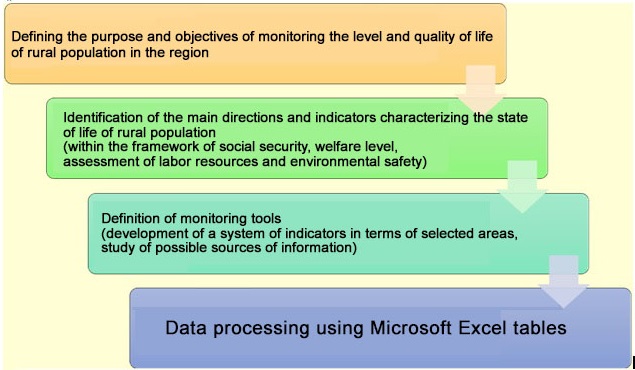
The indicators used in the methodology underlie the formation of municipalities rating in terms of the level and quality of life of rural residents. The indicators are studied in dynamics over a number of years (within the framework of the study, an interval of two years was considered); while some of them are compared with the standard values or with the average values for the region, if the standard for this indicator is not established. Depending on the dynamics of the presented indicators, each is assigned a score from -1 to 2 and, based on the overall assessment results; and then the rating of each municipal district (or rural settlement in the context of a municipal formation) is formed. According to the aggregate assessment, it is possible to identify rural areas with low potential and level of development, which makes it possible to develop appropriate management solutions aimed at eliminating both local and general problems.
We developed an electronic form of the Database for monitoring the social development of rural areas of the Omsk region to simplify the calculations in the Microsoft office Excel program. This calculation table allows the user to analyze the level of well-being of the population of rural areas, as well as labor activity, demography, unemployment rate. It allows assessing the development of social infrastructure, environmental safety, and identifies deviations from standard values or average values for the region. It should be mentioned that, considering the specifics of the conditions and characteristics of the life support of rural residents in various natural and climatic zones, the direction and structure of indicators may change.
The stages of working with the database are shown in Figure 2.
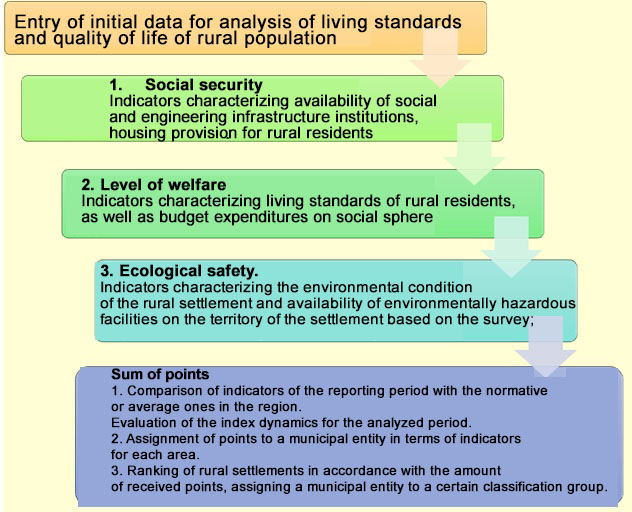
To calculate the indicators used, the user needs to enter the initial information in the appropriate tab (“Social security”, “Welfare level”, “Labor resources”, “Environmental safety”). After selecting a tab characterizing the quality of life of the rural population in the dialog box, a list of calculated indicators appears in the “Score” columns. Points are automatically calculated for each indicator.
On the tab “Rating of municipalities” on the basis of the automatic distribution of the initial data presented on the corresponding tabs, a rating of rural settlements characterizing the level and quality of life of the rural population is formed, which is based on the sum of points for each calculated indicator.
In accordance with the sums of points, the rating assessment proposes ranking of rural settlements and municipal districts according to four classification groups of the level of socio-economic development: the high level will include rural areas that scored from 51 to 62 points, the average - from 26 to 50 points, the low - from 1 to 25 points. If the sum of points is below zero, then these settlements (districts) are classified by us as territories with a crisis state.
Findings
A comprehensive analysis of the current situation, according to the above methodology, makes it possible to diagnose the problems of social development of rural areas of the Omsk region in four areas: social security, the level of well-being, environmental safety and the state of labor resources.
All the information collected, obtained on the basis of municipal statistics and a survey of representatives of the administrations of municipalities and rural settlements, was entered into the electronic form of the Database for monitoring the social development of rural areas on to the corresponding tabs. The program calculated indicators depending on the dynamics of their changes in points from minus one to two. The tab “Rating of municipalities” presents the sum of points and the result for all calculated indicators. The rating of rural settlements and municipal districts as a whole is determined in accordance with the score of the indicator, reflecting the average quality of life of the rural population in the corresponding territory. The sum of points in the context of the municipalities of the region is shown in Figure 3.
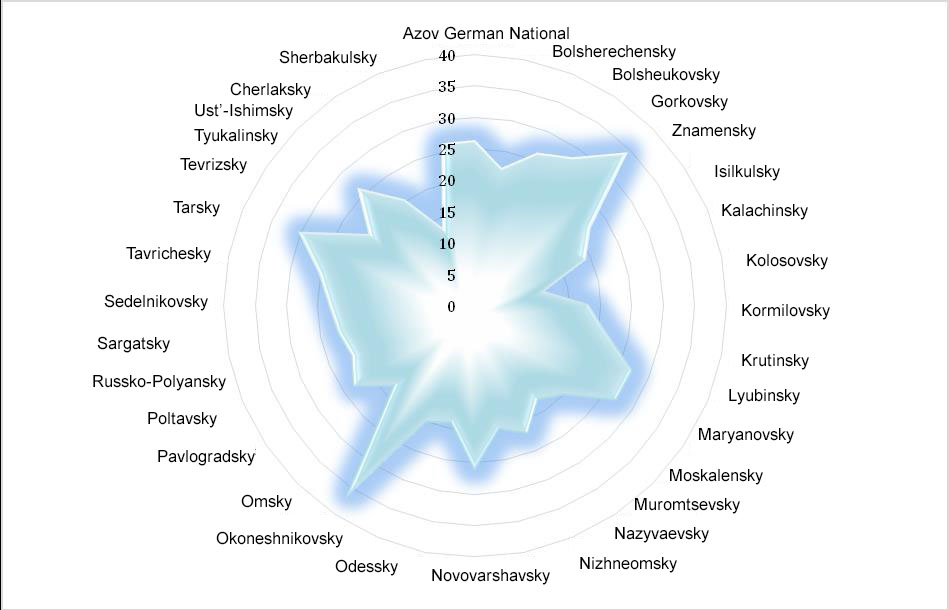
According to the study, it was found that out of 62 possible points, the maximum number of 36, 34 and 30 points is noted in Omsk, Znamensky and Tarsky districts, respectively. The minimum score was scored by such districts as Kolosovsky (11 points) and Cherlaksky (13 points), Kormilovsky, Muromtsevsky and Pavlogradsky which were rated at 18 points.
According to the results of the rating assessment, all municipal districts of the Omsk region were included in two groups, characterized by an average and low standard of living of the rural population (Table 1).
The analysis of the level of social development of rural settlements of the municipal districts of the region showed that the bulk of the municipalities belong to a low level of development. In these municipalities the social and engineering infrastructure is not developed, there is a low standard of living of the population; the level of environmental safety does not meet the requirements.
Only 33 settlements belong to the classification group characterizing the “average” standard of living of the rural population. Accordingly, these are settlements in which the development of all spheres of life is at an average level; several indicators can characterize development to a greater or lesser extent in relation to others.
At the same time, in the Omsk region there are two rural settlements with a crisis level of social development. These are Listvyazhinskoye rural settlement of the Bolsheukovsky region (rating score is minus three points) and Imshegalsky settlement of Tarsky district (with a rating score minus one point). In these settlements there is a low standard of living, no attention is paid to the development of social and engineering infrastructure, there is a poor level of environmental safety. As a result, there is an outflow of the population.
It should be noted that in the Tara region itself, the standard of living is characterized as “average”, but the rating of two rural settlements of this region does not exceed ten points (the rating of the Ust-Tarsky rural settlement is seven points, which corresponds to the low standard of living of the rural population).
There are no rural settlements with a high level of social development in the region (Figure 4).
In the course of the analysis of the data obtained, it was found that in the Novovarshavskiy Azov, Bolsheukovskiy and Sherbakulskiy municipal districts the rating score was 26 points, which corresponds to the threshold value for assigning a rating to the municipality, characterizing the “average” level of development. The Tavrichesky district of the region with a rating of 25 points lacked only one point in order not to get into the group indicating a “low” level of social development.
In order to determine why the municipality was included in this or that group of social development, an analysis of the ranking of rural areas was carried out in the context of the groups of studied indicators (Figure 5)
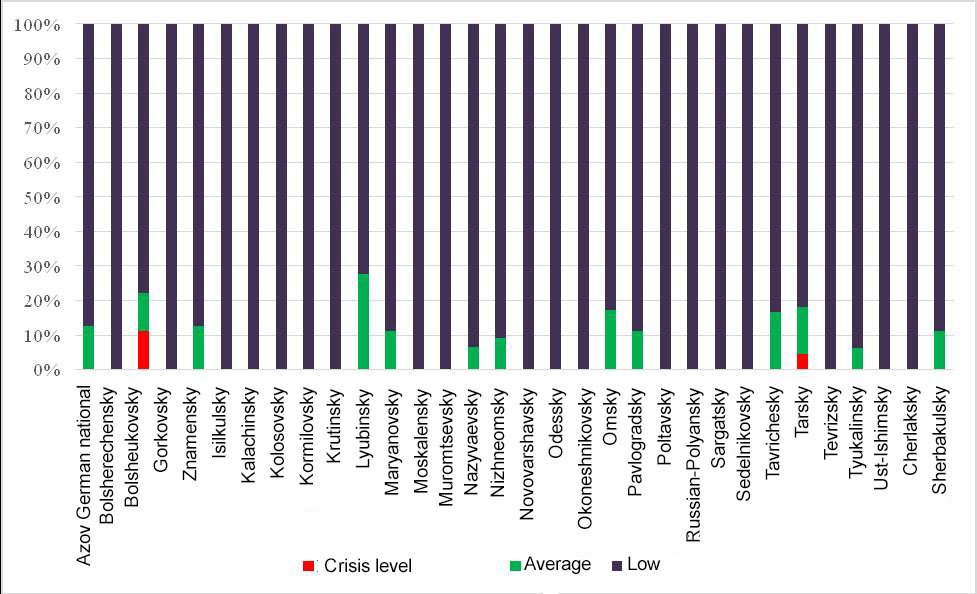
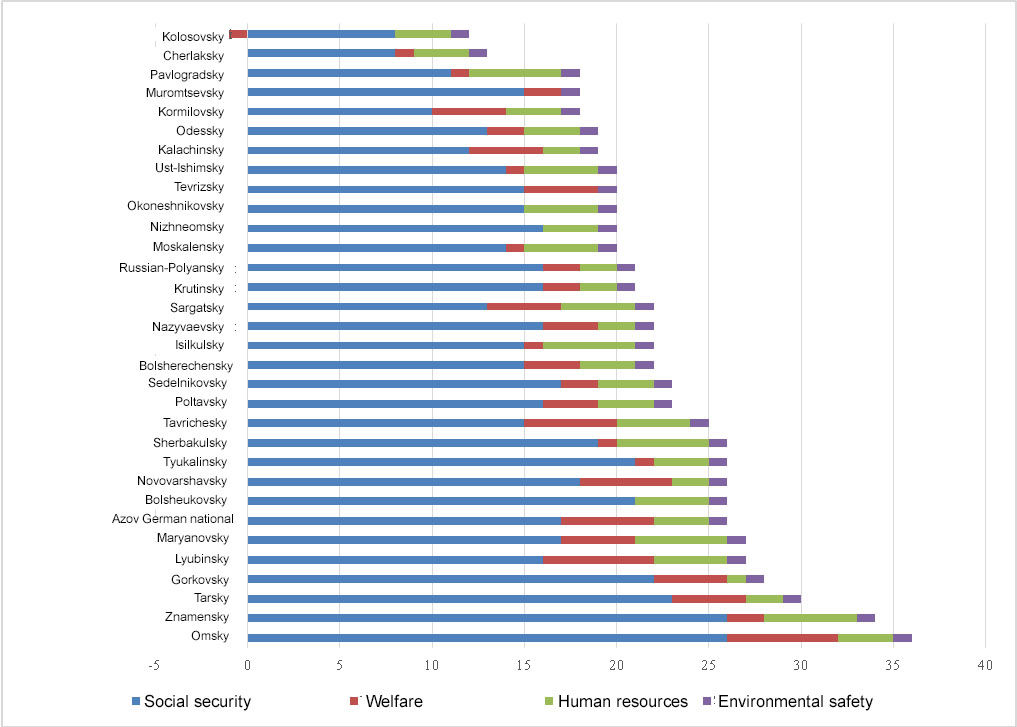
The first group of indicators characterizes the level of social security of rural residents. As in the general rating, the “leaders” in terms of the level of development of education, culture, health care, quality of housing conditions and other indicators of social infrastructure are Omsk and Znamensky districts. Of the maximum 40 points that could be obtained for this group of indicators, these municipalities received 26 and 27 points, respectively.
In the Omsk region, one of the problems of this block of indicators is the staffing of educational institutions with teachers, which “fell within the framework” of 50-70%. According to this criterion, the municipal district was assigned zero points. In addition, there is an increase in the number of families in need of better housing conditions (in accordance with the developed methodology, this indicator is assigned a minus one point). According to the survey, the state of sports facilities in rural settlements requires repair (zero points were assigned). One point was assigned to seven indicators out of twenty, which characterizes the indicators of social infrastructure at an average level.
In Znamensky District, zero points were assigned to the indicators of the state of sports facilities, the quality of road infrastructure, the level of gasification, the number of children's art and music schools. Minus one point was assigned due to the lack of social service institutions for the elderly and disabled.
If we analyze the level of well-being of rural residents, then the maximum number of points is noted in the Omsk and Lyubinsky districts of the region. Five points each in Azov, Novovarshavsky and Tavrichesky districts. Since for this group of indicators the districts received almost the maximum number of points, they “crossed the border” of 26 points in the final rating.
For the block “Labor resources” of the maximum 12 points, the highest value of the indicator of 5 points is observed in Znamenskiy, Maryanovskiy, Sherbakulskiy and Isilkulskiy districts.
According to the indicators of environmental safety, out of the maximum four points, all districts of the Omsk region were assigned one point, which indicates the insufficiently favorable ecological state of the rural areas of the region.
As a result, the Tavrichesky district was not included in the group of municipalities belonging to the average level of social development in the group of indicators (only 19 out of the maximum 40 points in the district, and only four out of the maximum 12 points in the district in terms of “labor resources”) (Table 2 ).
The administrations of rural settlements that fall into the category with a low and crisis level of development need to consider the possibilities of adjusting the strategic directions reflected in social policy. Particular attention should be focused on the possibility of expanding financing of the social sphere, in order to improve the state of infrastructure serving the rural population and the economy. In rural settlements with an average level of social development (Azov German National, Bolsheukovsky, Gorkovsky, Znamensky, Lyubinsky, Maryanovsky, Novovarshavsky, Omsky, Tarsky, Tyukalinsky, Sherbakulsky municipal districts), local authorities should promote the development of new types of economic activity on their territory, which will have a positive effect on securing labor resources, increasing jobs. As a result, it will increase the level and quality of life of the population.
Conclusion
Thus, the developed methodologies for a comprehensive assessment of the socio-economic development of rural areas makes it possible to timely and promptly identify problems in the social sphere, assess the level and quality of life of the rural population. It also helps to develop recommendations for the prevention and elimination of the consequences of negative processes. In addition, systematic monitoring will make it possible to assess the work of the existing systems of interaction between local self-government bodies, business entities and the population, predict their change, and timely identify and track the risks that limit their development.
This approach will allow the formation of the necessary information base to substantiate strategic decisions in the field of municipal management in the framework of the development of socio-economic policy aimed at improving the life of the rural population. The grouping of quality indicators according to criterion blocks will orient the administrative bodies to determine priority areas of development. It will identify “weak” points and localize problem situations. We see the presented grouping of life quality indicators as an effective tool in managing sustainable development of rural areas.
Acknowledgments
The research was carried out with the financial support of the RFBR and the Government of the Omsk region in the framework of the research project “Study of the system of indicators of the level and quality of life of the rural population, allowing to assess the results of social development of rural areas of the Omsk region” No. 18-410-550024 р_а.
References
Ayvazyan, S. A. (2002). Analysis of synthetic categories of the quality of life of the population of the constituent entities of the Russian Federation: their measurement, dynamics, main trends. Living standards of Russian regions, 11, 5-41.
Bobkov, V. N. (2009). Methodological approach of the All-Russian center of living standards to the study and assessment of the quality and standard of living of the population. VSU Bulletin. Series: Economics and Management, 2, 24-34.
Dmitrenko, E. A., & Golova, E. E. (2018). Indicators of the quality of life of the rural population. Moscow Economic Journal, 5(1), https://cyberleninka.ru/article/n/pokazateli-kachestva-zhizni-selskogo-naseleniya/viewer
Dmitrenko, E., Remizova, A., & Blinov, O. (2020). Indicators of social security in assessing the effectiveness of the implementation of social policy in the Omsk region. Proceedings of the international scientific conference the fifth technological order: prospects for the development and modernization of the Russian agro-industrial sector (TFTS 2019) (pp.166-172).
Faronova, Y. V., Akhunov, A. R., & Telnova, T. P. (2020). Spatial-temporal dynamics of the quality of life of the population of the RF subjects. The successes of modern natural science, 4, 163-168.
Kozlova, O. A. (2020). The mechanism of development of rural areas, considering regional specifics. Moscow Economic Journal, 6, 328-335.
Maslow, A. (1999). Motivation and personality. Saint-Petersburg: Eurasia.
Nikitina, T. I. (2019). Comprehensive methodology for assessing the level of sustainable socio-economic development of rural areas. Bulletin of the Kursk State Agricultural Academy, 4, 106-112.
Omsk Regional Statistics Service (2020). Statistical Report. Retrieved on 22 December 2020 from https://omsk.gks.ru
Program of the Omsk region “Strategy for the socio-economic development of the Omsk region until 2025”, Omsk province. Retrieved on November 15 from http://www.omskportal.ru/ru/government/strategy2025.html
Shmakov, V. S. (2020). The dynamics of socio-cultural transformation of the village: models of evolution. Siberian philosophical journal, 1, 99-109.
Shumakova, O. V., & Kutuzova, M. V. (2016). Monitoring of the level of socio-economic development of rural municipal districts (on the example of the Omsk region). Bulletin of the Oryol State Agrarian University, 5(62), 3-7.
Shuvalova, O. V. (2018). Living standard and quality of life: factors and Russian specificity. Research Azimuth: Economics and Management, 7, 1(22), 276-279.
Tretyakova, L. A., & Lavrikova, N. I. (2012). The quality of life of the population is an indicator of the sustainability of the development of rural areas. Economy of the region, 3(31), 227-233.
Veliky, P. P. (2019). Social mechanisms for improving the quality of life of the population of rural areas. Historical and socio-educational thought, 5, 91-107.
Veshnyakova, T. S., & Chentsova, N. M. (2008). Social policy and quality of life of the population. Bulletin of the Volga State University of Service. Series: Economics, 3, 39-47.
Yurkova, M. S., Firsov, A. I., Trofimova, V. I., & Ermakova, G. A. (2020). Modern Methods of Ensuring Sustainable Development of Rural Territories at the Regional Level. IOP Conference Series Earth and Environmental Science, 459, 062015.
Zaitseva, O., Baetova, D., Golova, E., & Kozlova, O. (2020). Standard of living and quality of life of rural population in the Omsk region. Proceedings of the international scientific conference the fifth technological order: prospects for the development and modernization of the Russian agro-industrial sector (TFTS 2019) (pp. 156-161).
Copyright information

This work is licensed under a Creative Commons Attribution-NonCommercial-NoDerivatives 4.0 International License.
About this article
Publication Date
01 July 2021
Article Doi
eBook ISBN
978-1-80296-112-6
Publisher
European Publisher
Volume
113
Print ISBN (optional)
-
Edition Number
1st Edition
Pages
1-944
Subjects
Land economy, land planning, rural development, resource management, real estates, agricultural policies
Cite this article as:
Dmitrenko, Е. А., & Remizova, А. А. (2021). Comprehensive Assessment Of The Socio-Economic Development Level Of Omsk Municipal Districts. In D. S. Nardin, O. V. Stepanova, & V. V. Kuznetsova (Eds.), Land Economy and Rural Studies Essentials, vol 113. European Proceedings of Social and Behavioural Sciences (pp. 348-360). European Publisher. https://doi.org/10.15405/epsbs.2021.07.42

